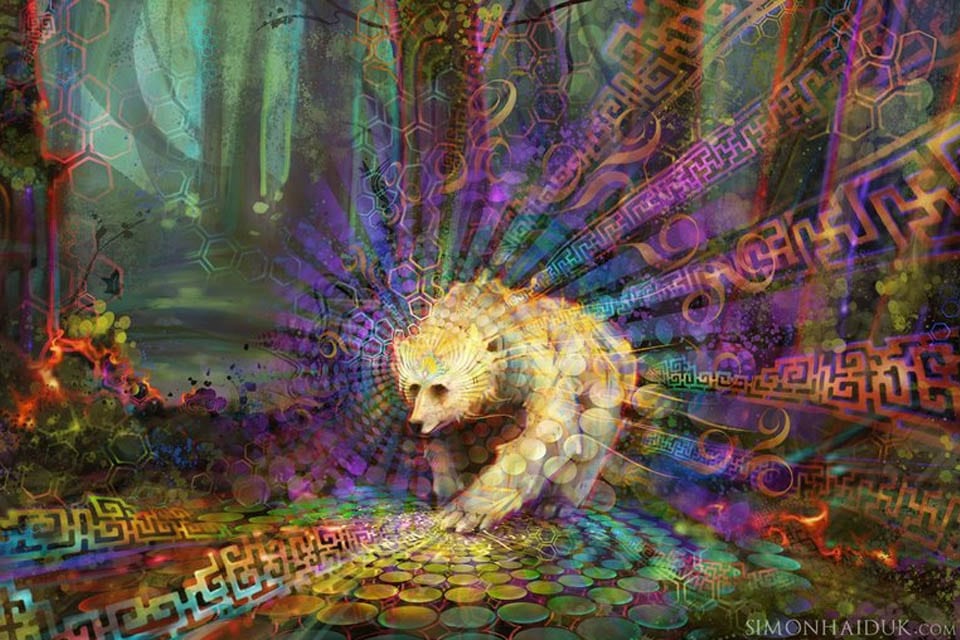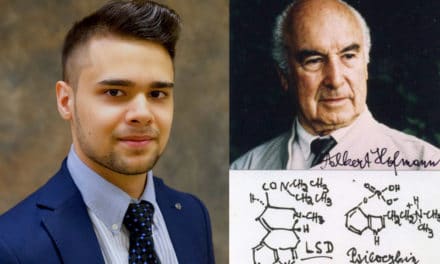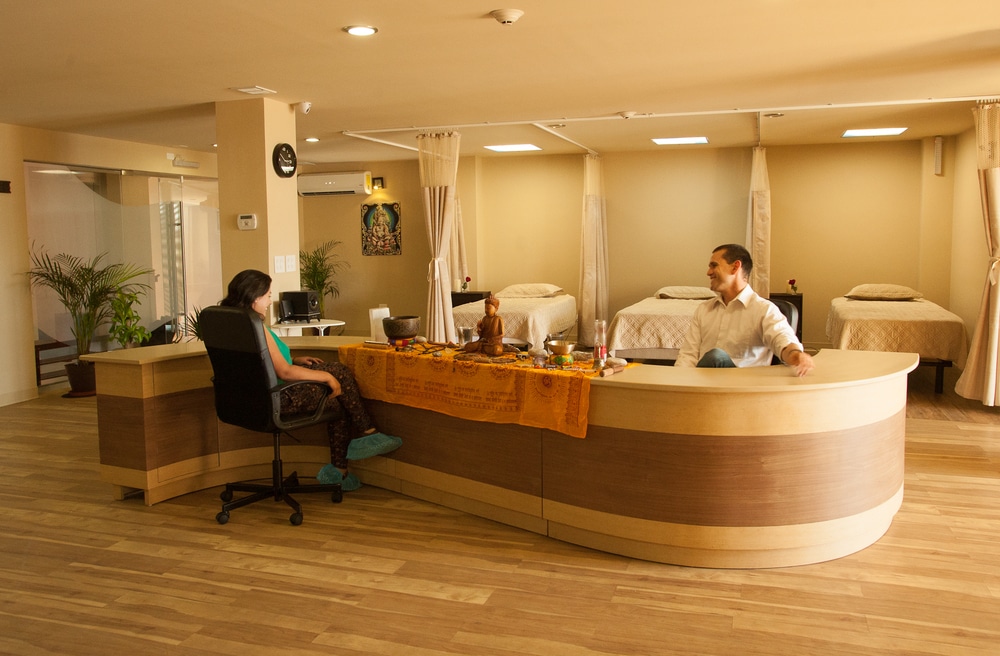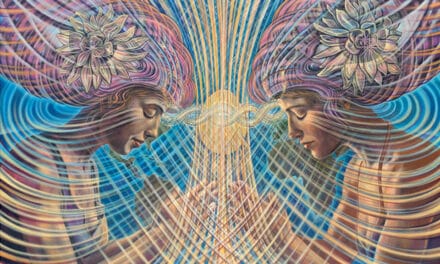Simon Haiduk is a visionary artist, animator and musician from British Columbia, Canada. His beautiful and distinctive artwork embodies metaphysical and natural themes, and has been featured across the United States and Canada at festivals, galleries, public spaces, and even in MAPS publications. I spoke with Simon from his home in B.C. about his path to becoming an artist, and the role that psychedelics played in that process.
Thanks for taking the time to speak with us, Simon. I would classify your art as “fucking sick!” It’s really incredible.
Thank you! We’re using proper millennial terms, I see.
[Laughs] I’m really excited to be covering more visionary art on Psychedelic Times, with my recent conversation with David Jay Brown and Rebecca Ann Hill and now this conversation. To start off, can you share a bit about your background, and perhaps how psychedelics played a part in it?
I’ve been drawing and painting for as long as I can remember, and got really into music as a teenager. In my early 20’s I was doing basement recordings of albums, and I would experiment with watercolors and oil, but it was nothing particularly psychedelic. I didn’t even know what psychedelic art was beyond trippy fractals or fluorescent paints and things like that.
In winter 2003, I started a series of intentional LSD journeys with a friend. He said, “We gotta do 3 tabs and only listen to Tool on repeat!” I was really new to Tool back then, and said “Alright man, let’s do it.” They were extraordinary experiences, and there was one in particular that I call “my awakening” where I transfigured out of my body into a particle of light and had this whole journey with all these messages that came to me. It was a deep journey and has a full story to it that I won’t get into, but coming back from it I definitely felt keyed in to a path of doing art.
My higher self told me that I was going to meet other artists soon who were along the same path, and sure enough all these synchronicities started happening that year. I met a bunch of other artists and ended up going to an Alex Grey workshop. It was a really quick snowball into the Western visionary art and North American festival scene. I was picked up by a group of artists called Tribe 13 who were exhibiting at Shambhala. I had a few prints of paintings up and they really liked them, so I did some festivals with them over a few years. Then I wanted to branch out and I felt called to animation, so I went to Vancouver Film School and that’s where I learned more about digital media: motion graphics, audio, web design, Photoshop, and so on.
From there on, I’ve mostly been doing my own thing; I’ve never done a lot of commercial stuff. Psychedelics continually play a role in inspiring me and what I’m portraying with visual art and music, and I’m often weaving the two together.

Eden’s Dream by Simon Haiduk, Limited Edition book cover for “Love and Other Pranks” by Tony Vigorito
That’s awesome. Let’s talk about the festival scene you mentioned. The music, the art, the use of psychedelics— they are all very intertwined. I was pretty deep into the festival scene too, but found myself getting somewhat jaded after a couple of years. I’ve spoken with James Oroc and Random Rab about this before. What is your take on the “transformational festival” movement? Do you still attend them, and do you get a lot out of them? Is it just a venue for your art? Do they still retain that powerful seed of transformation for people, or are they getting too corporate now?
Yeah, like I said… after a few years of doing a handful of those festivals, I did start to have a sense of jadedness and wondered, “Is this really what it’s saying it is?” That’s also why I went to school, to apply myself in a different way. But I do think that festivals provide a really great container for people to experience a certain type of freedom that is not really available elsewhere, and a unique space to experiment with psychedelics.
The dance floor is a special place, but it’s a double edged sword. On the one hand, it can be powerful and cathartic for people to have a deep shamanic journey while dancing, but I think especially now that things are so flashy, people get more absorbed into the scene and the glitz, and they are not having an actual transformational experience in a deep way. People are just having their minds blown, like “Oh my god what is this crazy stage with all these lights and sounds!”
I tend to prefer journeys where I’m either by myself or with a small group of people and I can really process what’s going on inside myself: see my shadow, see the light, see the different ways that I can integrate… and I don’t think festivals really provide that. And in fact, a lot of them were doing workshops about these things early on, but then just stopped. Shambala festival specifically was pushing out any idea of workshops, just hammering in the point of “This is a party, this is a rave, forget workshops, forget any personal growth shit!” [Laughs]
So yeah, I am super jaded in a lot of ways about festivals. I still go to them from time to time because they are a good venue for me to show my art— people connect with the art very well there— but I’ve kept it pretty minimal over the years, and have been more selective.
I do enjoy encounters with people at festivals, because people are really open and often their hearts are expanded and you can have some beautiful and friendly conversations off the dance floor. At a lot of the big ones, I barely go to the dance floor because it’s so insanely loud— even with earplugs— that I feel sick, which is crazy. Do we really need to keep getting louder and louder? So I’ve got mixed feelings, but I’m leaning toward doing less and less, and I average about one or two a year nowadays.

OvO – by Simon Haiduk & David Heskin – oil and digital painting – 2016
Yeah, and of course it’s a spectrum, right— it’s not that they are totally amazing or that they suck; it’s a mix of both.
Yeah and it depends on which one, too. There are the smaller, more intimate ones, and then there are the really big, crazy ones that are more corporate or over the top.
I had an extraordinarily powerful kind of initiation and awakening experience at my first festival, a local burn event in Texas, but over the years you start to see the larger patterns. There are those intimate groups of friends or strangers having a really heart-opening experience together and deeply connecting, off in a camp or an art display or something, and then you have the ultra-loud, Molly-and-coke-fueled dance floor where people are taking mushrooms because its cool, and there is no therapeutic or even purely authentic space for them to be in their experience, and you can sort of tell when people are getting in quite a bit over their heads. And it feels like it’s slid a little bit more in that later direction, but on the whole I think it’s a profoundly important and beautiful movement with a lot of potential, an attempt at recreating the perennial Eleusis.
Yeah, I think that they’re just a space to give people a chance to awaken to something other than mainstream modern existence. Although it is being more and more appropriated now and I’m less invested, they definitely serve an important purpose.
So I wanted to ask you: of course every artist has a slew of motivations. What is it within you that compels you to make art? Is it to instill a transformational experience in the viewer? It is because the art is within you and simply needs to come out? Do you have any specific intentions, particularly in regards to nature, which play an important role in your art?
It’s all of the above, really. It definitely feels like something innate to me that needs to be expressed for my own wellbeing and process here on Earth, and it’s a way to translate my metaphysical experiences into the physical world. Nature is such a potent connective space, and we are intrinsically part of it. Being able to express metaphysical things within nature and with animals highlights our intimate connection to them and is a reminder of the all the symbiotic relationships that bring about life and help it to thrive. My art is a process to remind myself of that, and hopefully to remind others and connect them to it as well. It’s all about connection.
Simon Haiduk – Mettamorphs – Demo Reel from Simon Haiduk on Vimeo.
Are you working on any new projects right now that you’d like to share?
What I’m working on right now is an interactive experience that I’m calling Metta Grove. The first one was initiated when a friend reached out to me and said she wanted to borrow some tapestries and my artwork to have an intentional journey in her home. So I said, why don’t you just hire me and I’ll come out and do live visuals, play ambient music and decorate your space with tapestries and such?
So we did that. A group of people came, it opened up with a cacao ceremony, and it was a really awesome experience to merge a light medicine journey with a more casual social atmosphere that had a performance aspect to it. It wasn’t a party, it was a gathering, and it wasn’t so serious as a deep medicine journey where people are tripping balls. With the small dose and the cacao opening, it was really great.
I did another one in the park after cannabis was legal. It was part of the Spirit Plant Medicine Conference with about 500 people at UBC, and on Saturday night we had a cannabis ceremony and a sound journey where I was doing visuals on these two large screens.
To me, the idea is to create a multimedia art experience and community gathering where we unite live performance and community connection with a devotional meditative atmosphere. Sometimes some gatherings are too “woo,” you know what I mean? Or they are too much party. And so we’re trying to create beautiful intentional experiences that don’t exclude people who don’t want to be part of meditative or spiritual things, but who are interested in art and novel experiences.
This sounds a lot like distilling the good parts of these larger festivals into a smaller and more intentional form.
Exactly. We want to feel a wholesome, heart opening connection to others in a space where we can socialize, especially after an intentional plant medicine experience, but small enough that when you come out of it you’re able to still connect with people about that experience. You’re in this heart and mind-opened space, but it’s not about blaring music and sexualized costumes, it’s just chilling out in a home or small venue. So that’s something I’m working on and excited to bring to more spaces.
Due to legalities, we’ll be working a lot with cannabis. A lot of my work is about our connections to plants and plant consciousness, and how when we intentionally connect with that and it enters our being, it’s such a potent threshold for transformation and connection to everything around us. You can take a substance recreationally at a party and have this mind-blowing experience, but did you actually consciously think, “I’m ingesting another conscious being that is altering my chemistry; it’s communicating with me and perhaps I can communicate with it?” I think that is possible with cannabis. I love cannabis— it’s been super valuable for me in my process. But of course this process doesn’t need to include plant medicines at all, so we’re toying with different concepts. I’m really excited to see these Metta Grove experiences continue to unfold and evolve.
We are very grateful to Simon for sharing his story, ideas, and projects with us. Check out his incredible artwork at https://simonhaiduk.com/











